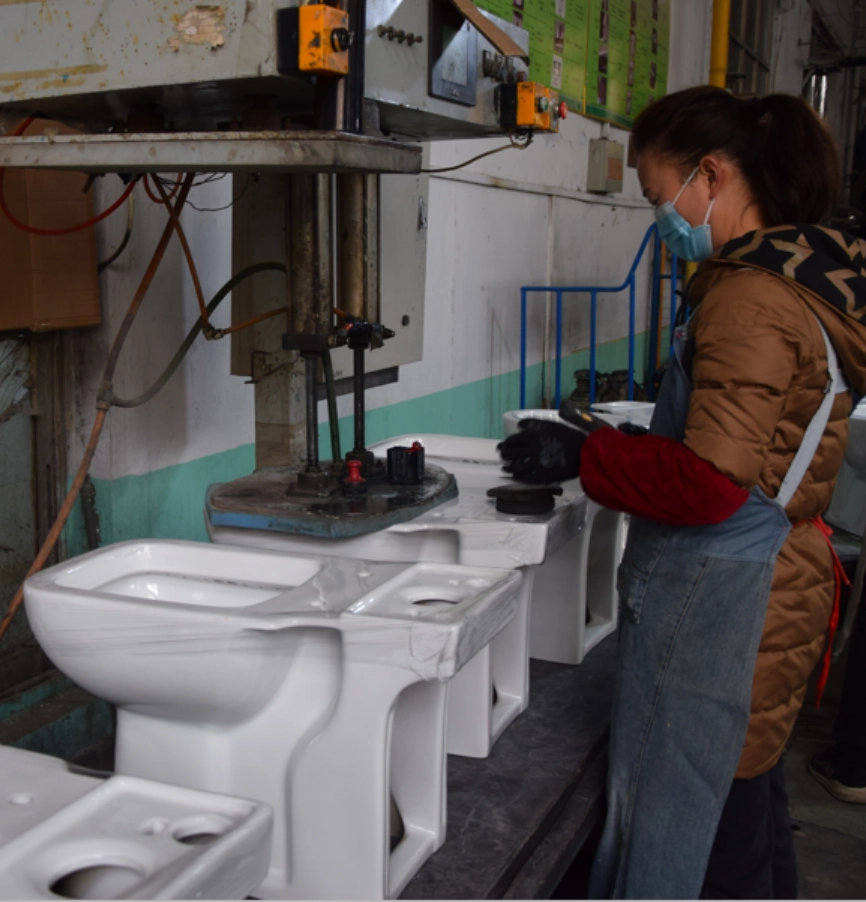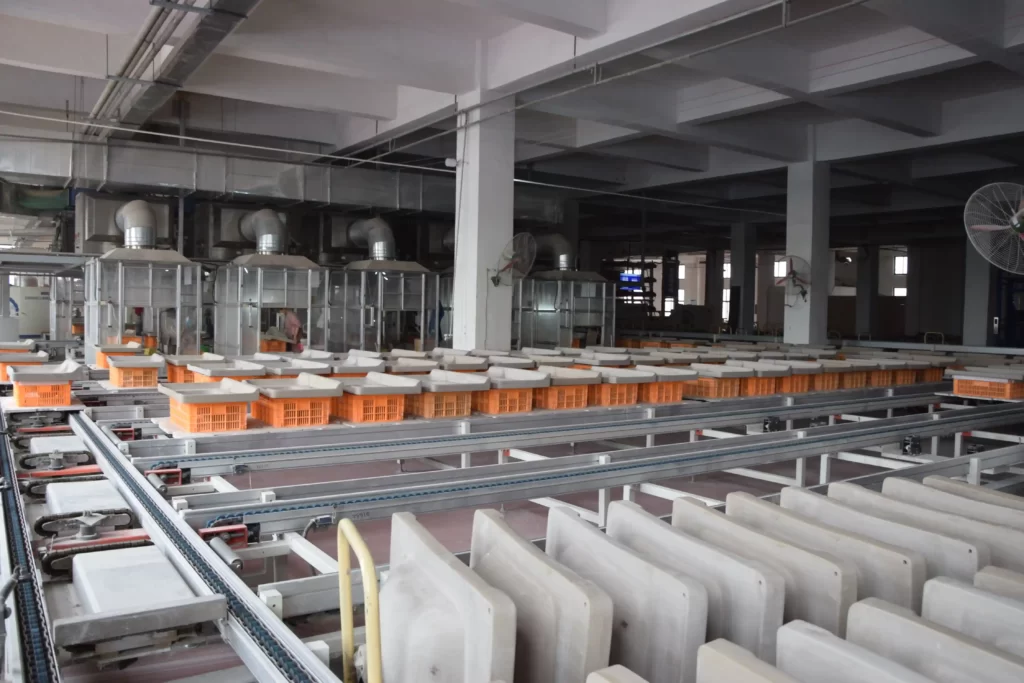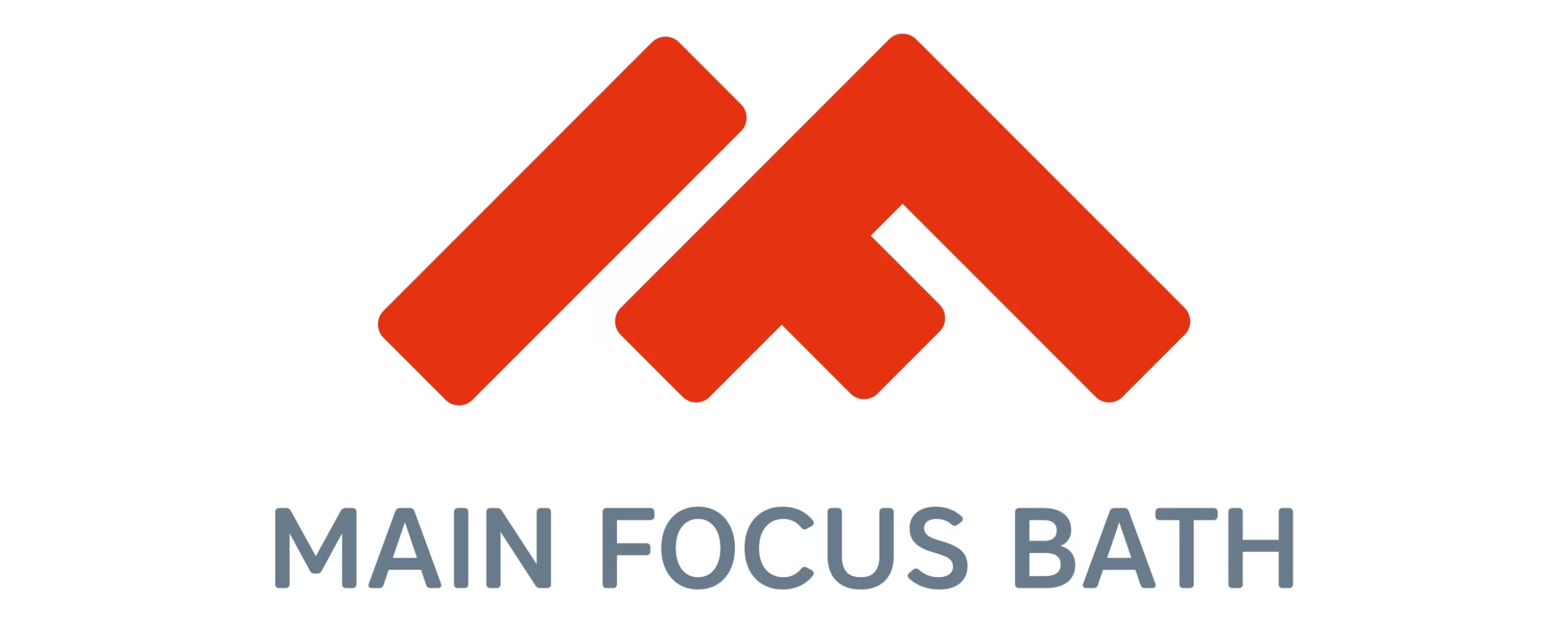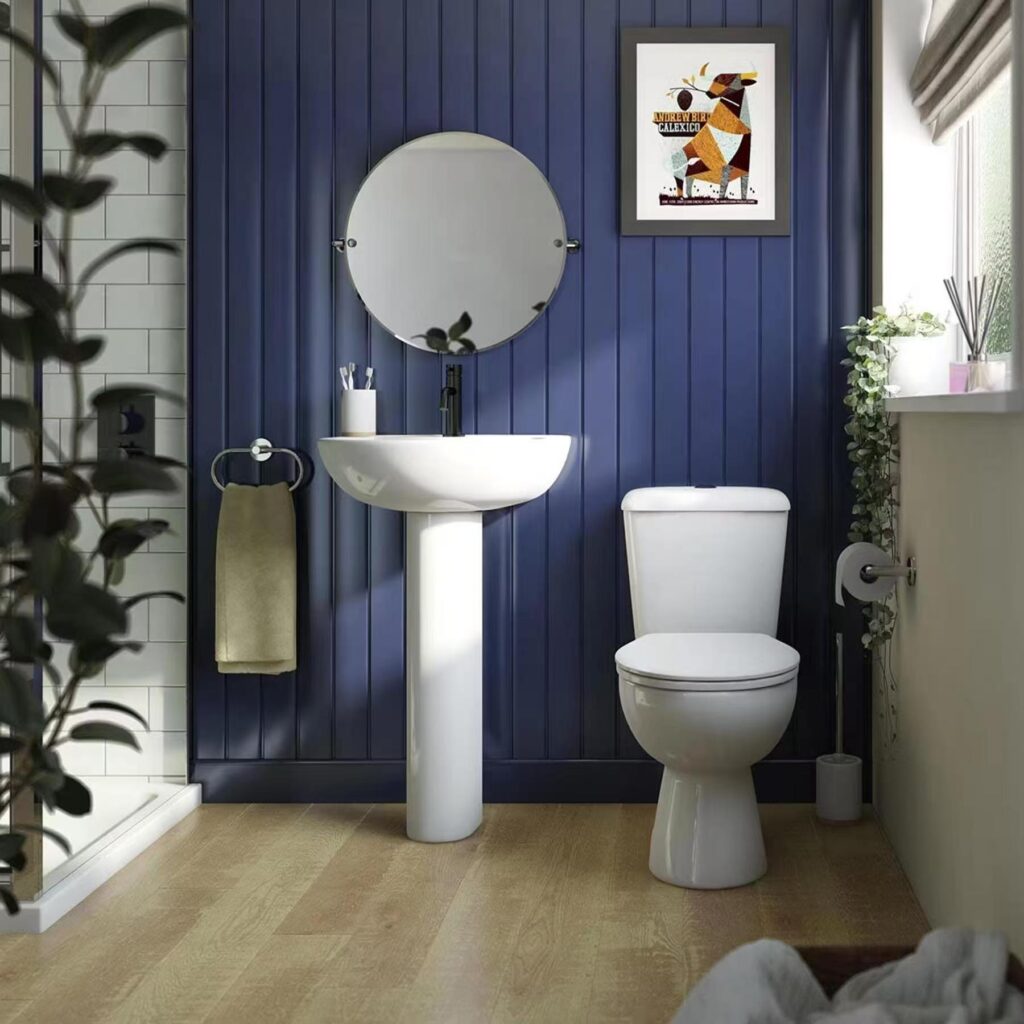Bekendstelling
In today’s competitive commercial bathroom market, generic ceramic toilets no longer cut it. Wholesalers and retailers face mounting pressure to offer unique, branded fixtures that blend aesthetics with cutting-edge technology. But how do you navigate the complex world of customized ceramic toilet manufacturing without compromising on quality or breaking the bank?
This challenge is precisely why the industry is seeing a surge in demand for personalized sanitary ware solutions. From incorporating company logos and custom color schemes to integrating smart features like touchless flushing and self-cleaning systems, the possibilities for differentiation are vast. However, finding the right balance between customization, functionality, and cost-effectiveness often proves to be a daunting task for many businesses.
In this comprehensive guide, we’ll break down the entire process of creating branded, feature-rich ceramic toilets. We’ll explore everything from design options and smart technology integration to supplier vetting and production timelines. Whether you’re looking to elevate your product line with “next-level” personalized fixtures or seeking ways to streamline your customization process, this article will equip you with the knowledge to make informed decisions and stay ahead in the evolving sanitary ware market.
The Fundamentals of Customized Ceramic Toilet Manufacturing
In today’s competitive commercial bathroom market, customized ceramic toilet manufacturing has become a “spelwisselaar” for businesses looking to stand out. As a Technical Sales Manager at MFBath, I’ve witnessed firsthand how personalized sanitary ware solutions can transform the industry landscape. Let’s dive into the essentials of this innovative approach and explore why it matters for wholesalers and retailers alike.
What is Customized Ceramic Toilet Manufacturing? Core Concepts and Benefits
Customized ceramic toilet manufacturing involves tailoring toilet designs to meet specific client requirements, brand aesthetics, or functional needs. This process goes beyond standard production, allowing for unique features, colors, and even smart technology integration. The benefits are numerous:
- Brand differentiation
- Increased customer satisfaction
- Higher profit margins
- Ability to target niche markets
“Customized ceramic toilet manufacturing enables businesses to offer unique, branded solutions that cater to specific market demands and enhance brand loyalty.”
Why Customization Matters for Wholesalers and Retailers
In an increasingly crowded market, offering customized ceramic toilets can set your business apart. Wholesalers and retailers can leverage this to:
- Create exclusive product lines
- Meet diverse customer preferences
- Strengthen partnerships with architects and designers
- Increase perceived value of products
By partnering with a manufacturer like MFBath, you gain access to expertise in ceramic toilet customization, allowing you to offer unique products that resonate with your target audience.
Key Industry Trends Driving Demand for Personalized Toilets
Several trends are fueling the growth of customized ceramic toilet manufacturing:
| Trend | Impact on Design | Consumer Demand | Market Growth (%) | Adoption Rate |
|---|---|---|---|---|
| Eco-Friendly Solutions | Water-saving features | Hoog | 15 | Rapid |
| Smart Technology | IoT integration | Gematig | 22 | Growing |
| Minimalist Aesthetics | Sleek, compact designs | Hoog | 18 | Steady |
| Hygiene-Focused Features | Touchless operation | Baie hoog | 25 | Rapid |
| Luxury Materials | High-end finishes | Gematig | 10 | Niche |
These trends highlight the diverse opportunities in customized ceramic toilet manufacturing, from eco-conscious designs to high-tech solutions.
Overview of the OEM Process for Custom Toilets
The OEM (Original Equipment Manufacturer) process for custom toilets typically involves:
- Initial consultation and design brief
- Prototype development and approval
- Mold creation
- Small batch production for testing
- Quality control and adjustments
- Full-scale production
At MFBath, we guide our clients through each step, ensuring that the final product meets both aesthetic and functional requirements. Our expertise in ceramic toilet customization allows us to overcome common challenges and deliver high-quality, branded ceramic toilets that stand out in the market.
As the demand for personalized bathroom solutions continues to grow, understanding how to customize ceramic toilets with brands becomes crucial. By partnering with an experienced manufacturer, you can tap into this lucrative market and offer unique products that resonate with modern consumers.

Design and Branding Options for Ceramic Toilets
As the ceramic sanitary ware industry evolves, the demand for unique, branded toilet designs continues to grow. At MFBath, we’ve seen firsthand how customized ceramic toilet manufacturing can transform ordinary fixtures into “show-stoppers” that reflect a brand’s identity and values. Let’s explore the exciting world of design and branding options for ceramic toilets.
Incorporating Logos, Colors, and Patterns for Brand Identity
One of the most effective ways to customize ceramic toilets is through visual branding elements. This can include:
- Embossed or printed logos on the tank or bowl
- Custom color schemes that match brand palettes
- Unique patterns or textures on the surface
These elements not only make the toilet visually appealing but also reinforce brand recognition. For example, a luxury hotel chain might opt for gold-plated fixtures with their logo subtly embossed on the tank.
“Branded ceramic toilets offer a unique opportunity to extend a company’s visual identity into every corner of their space, creating a cohesive and memorable experience for users.”
Minimalist vs. Ornate Design Trends in Ceramic Toilets
Current design trends in ceramic toilet customization generally fall into two categories:
- Minimalist: Clean lines, simple shapes, and neutral colors
- Ornate: Intricate details, bold colors, and decorative elements
The choice between these styles often depends on the brand’s image and target market. A tech startup might prefer a sleek, minimalist design, while a boutique hotel could opt for an ornate, vintage-inspired look.
Material Selection for Aesthetic and Functional Appeal
While ceramic remains the primary material for toilets, various finishes and additives can enhance both aesthetics and functionality. Here’s a comparison of some popular options:
| Material/Finish | Aesthetic Appeal | Functional Benefits | Durability (1-10) | Cost Factor |
|---|---|---|---|---|
| Standard Ceramic | Classic, versatile | Easy to clean | 7 | 1x |
| Glazed Porcelain | Smooth, glossy | Stain-resistant | 8 | 1.2x |
| Matte Finish | Modern, sophisticated | Fingerprint-resistant | 7 | 1.1x |
| Nano-coated Ceramic | Sleek, high-tech | Self-cleaning properties | 9 | 1.5x |
| Colored Ceramic | Bold, customizable | Brand alignment | 7 | 1.3x |
At MFBath, we work closely with clients to select the best materials for custom ceramic toilets that balance aesthetic appeal with practical functionality.
Case Studies of Successful Branded Toilet Designs
Let’s look at two examples of how ceramic toilet customization has been successfully implemented:
- Eco-Resort Chain: Commissioned toilets with a leaf-patterned relief and water-saving technology, reinforcing their commitment to sustainability.
- Tech Company Headquarters: Installed smart toilets with the company logo illuminated on the lid, showcasing their innovative brand identity.
These case studies demonstrate how branded ceramic toilets can effectively communicate a company’s values and enhance the overall user experience.
In conclusion, the world of customized ceramic toilet manufacturing offers endless possibilities for creating unique, branded fixtures. By carefully considering design elements, materials, and branding options, businesses can create toilets that not only serve their functional purpose but also contribute to a cohesive brand experience.

Integrating Smart Technology in Ceramic Toilets
In the realm of customized ceramic toilet manufacturing, the integration of smart technology has become a “spelwisselaar”. As a Technical Sales Manager at MFBath, I’ve witnessed firsthand how these innovative features are revolutionizing the bathroom experience. Let’s explore the exciting world of smart ceramic toilets and their impact on the industry.
Popular Smart Features: Bidet Functions, Touchless Flushing, and Self-Cleaning Systems
Smart ceramic toilets come with a range of advanced features that enhance hygiene and user comfort:
- Bidet functions with adjustable water pressure and temperature
- Touchless flushing systems activated by motion sensors
- Self-cleaning capabilities using UV light or electrolyzed water
- Heated seats with temperature control
- Automatic lid opening and closing
“The integration of smart features in ceramic toilets not only enhances user experience but also positions retailers as providers of cutting-edge bathroom solutions.”
IoT-Enabled Toilets and Their Benefits for Commercial Spaces
Internet of Things (IoT) technology is taking smart toilets to the next level, particularly in commercial settings:
| IoT Feature | Functionality | Commercial Benefit | User Satisfaction (%) | Maintenance Efficiency (%) |
|---|---|---|---|---|
| Usage Analytics | Tracks toilet usage patterns | Optimized cleaning schedules | 85 | 30 |
| Afgeleë diagnostiek | Monitors toilet health | Proaktiewe onderhoud | 90 | 40 |
| Water Consumption Tracking | Measures water usage | Resource management | 75 | 25 |
| Occupancy Sensors | Detects stall availability | Improved user experience | 95 | 20 |
| Automated Supply Ordering | Reorders toilet paper, soap | Streamlined inventory | 80 | 35 |
Eco-Friendly Features: Water-Saving and Sustainable Technologies
Smart ceramic toilets often incorporate eco-friendly features:
- Dual-flush systems for water conservation
- Greywater recycling capabilities
- Energy-efficient hand dryers
- Sustainable materials in manufacturing
These features not only reduce environmental impact but also appeal to environmentally conscious consumers and businesses.
Challenges and Solutions in Smart Toilet Customization
While integrating smart features in ceramic toilets offers numerous benefits, it also presents challenges:
- Cost: Smart features can increase production costs. Solution: Modular designs allow for scalable smart options.
- Complexity: More features mean more potential points of failure. Solution: Rigorous testing and quality control processes.
- User Interface: Ensuring intuitive controls for diverse users. Solution: User-centric design and customizable interfaces.
- Power Requirements: Smart features need electricity. Solution: Energy-efficient designs and backup power options.
At MFBath, we address these challenges head-on, offering custom bathroom solutions that balance innovation with reliability and user-friendliness.
The integration of smart technology in customized ceramic toilet manufacturing opens up a world of possibilities for wholesalers and retailers. By offering toilets with advanced features, businesses can cater to tech-savvy consumers and position themselves as leaders in innovative bathroom solutions. As the demand for smart ceramic toilets continues to grow, staying informed about the latest options for smart features in ceramic toilets will be crucial for success in this evolving market.

Selecting and Vetting Suppliers for Quality Assurance
In the world of customized ceramic toilet manufacturing, choosing the right supplier is crucial for ensuring consistent quality and meeting customer expectations. As a Technical Sales Manager at MFBath, I’ve learned that a reliable supplier can be a “spelwisselaar” for your business. Let’s explore the key factors in selecting and vetting suppliers for your custom bathroom solutions.
Key Criteria for Choosing Reliable Suppliers
When evaluating ceramic sanitary ware suppliers, consider the following criteria:
- Production capacity and scalability
- Quality control processes
- Technical expertise and innovation
- Financial stability
- Industry reputation and references
“Selecting the right supplier for customized ceramic toilet manufacturing can significantly impact your product quality, delivery times, and overall customer satisfaction.”
Importance of CE Certification and Industry Standards
Certifications play a crucial role in ensuring product quality and compliance. Here’s a comparison of key industry standards:
| Certification | Scope | Importance (1-10) | Market Recognition | Renewal Frequency |
|---|---|---|---|---|
| CE Marking | European Economic Area | 9 | Hoog | Ongoing |
| ISO 9001 | Quality Management | 8 | Globaal | 3 years |
| WRAS | Water Regulations (UK) | 7 | High in UK | 5 years |
| IAPMO | Plumbing (North America) | 8 | High in NA | Annual |
| Green Label | Environmental Standards | 6 | Growing | 3 years |
At MFBath, we prioritize CE certification and adhere to stringent quality standards, ensuring our products meet global requirements.
Strategies for Negotiating Long-Term Contracts
Establishing long-term partnerships with suppliers can provide numerous benefits:
- Negotiated pricing for bulk orders
- Priority production scheduling
- Collaborative product development
- Customized support and services
When negotiating contracts, focus on mutual benefits and clear communication of expectations. This approach has helped MFBath build strong, lasting relationships with our clients in the customized ceramic toilet manufacturing industry.
Evaluating Supplier Support and Scalability for Bulk Orders
As your business grows, your supplier should be able to scale with you. Consider these factors:
- Production capacity expansion plans
- Technical support for customization
- Inventory management solutions
- Quality control for large-scale production
MFBath’s robust support services ensure consistent quality and reliable delivery schedules, even for large-scale orders. Our expertise in how to customize ceramic toilets with brands allows us to meet diverse client needs efficiently.
In conclusion, selecting the right supplier for customized ceramic toilet manufacturing is a critical decision that impacts your entire business. By carefully evaluating potential partners based on quality, certifications, and support capabilities, you can establish a reliable supply chain that meets your customers’ expectations and supports your business growth.

Navigating the OEM Production Process and Timelines
As a Technical Sales Manager at MFBath, I’ve guided countless clients through the intricate process of customized ceramic toilet manufacturing. Understanding the OEM production journey is crucial for wholesalers and retailers looking to create “top-notch” branded ceramic toilets. Let’s break down this process and explore how to optimize your bulk orders.
Step-by-Step OEM Process: Design, Prototyping, Manufacturing, and Delivery
The OEM production process typically involves these key stages:
- Design Consultation
- 3D Modeling and Approval
- Prototyping
- Mold Creation
- Sample Production
- Mass Production
- Quality Control
- Packaging and Shipping
“A well-managed OEM process in customized ceramic toilet manufacturing can significantly reduce time-to-market while ensuring high-quality, branded products that meet specific customer needs.”
Typical Production Timelines (8-12 Weeks) and Factors Affecting Delays
While timelines can vary, here’s a general breakdown of the production process:
| Stage | Duration (Weeks) | Potential Delays | Impact on Timeline | Mitigation Strategies |
|---|---|---|---|---|
| Design and Approval | 1-2 | Design revisions | Medium | Clear initial brief |
| Prototyping | 2-3 | Material issues | Hoog | Pre-approved materials |
| Mold Creation | 3-4 | Complex designs | Baie hoog | Simplified designs |
| Sample Production | 1-2 | Quality issues | Medium | Rigorous QC process |
| Mass Production | 1-2 | Supply chain disruptions | Hoog | Multiple suppliers |
Cost Optimization Through Strategic Planning and Negotiations
To optimize costs in ceramic toilet customization:
- Bundle orders for volume discounts
- Plan for seasonal demand fluctuations
- Negotiate long-term contracts with suppliers
- Consider modular designs for flexibility
At MFBath, we work closely with clients to find the best materials for custom ceramic toilets that balance quality and cost-effectiveness.
Tips for Streamlining Bulk Order Logistics
Efficient bulk order management is crucial in customized ceramic toilet manufacturing:
- Forecasting: Use data analytics to predict demand accurately.
- Inventory Management: Implement just-in-time practices to reduce storage costs.
- Quality Control: Establish checkpoints throughout the production process.
- Communication: Maintain open lines with your manufacturer for real-time updates.
MFBath’s streamlined OEM processes ensure that wholesalers can achieve cost-effective, high-quality production while meeting tight delivery schedules. Our expertise in ceramic toilet customization allows us to navigate potential challenges and deliver branded ceramic toilets that meet your specific requirements.
By understanding the intricacies of the OEM production process, you can better plan your bulk orders, minimize delays, and optimize costs. This knowledge is invaluable in creating a competitive edge in the market for custom bathroom solutions.

Konklusie
After diving deep into the world of customized ceramic toilet manufacturing, I’ve seen firsthand how this industry is transforming. It’s not just about making toilets anymore—it’s about creating branded experiences that resonate with customers and set businesses apart.
From sleek designs and smart features to eco-friendly innovations, the possibilities are truly endless. As a Technical Sales Manager at MFBath, I’ve guided countless clients through this process, and I can tell you it’s a “spelwisselaar” when done right. The key? Finding that sweet spot between cutting-edge customization and reliable quality.
So, whether you’re a wholesaler looking to expand your product line or a retailer aiming to offer unique bathroom solutions, remember: in today’s market, personalization isn’t just an option—it’s a necessity. Embrace the world of custom ceramic toilets, and you’ll be flush with success in no time.
Vrae
-
Q1: What are the benefits of customized ceramic toilets?
A1: Customized ceramic toilets can be tailored to meet specific needs, allowing for better design integration, enhanced functionality, and improved comfort for users.
-
Q2: How can I find reputable manufacturers for custom ceramic toilets?
A2: Consider looking for manufacturers with a solid track record, positive customer reviews, and relevant industry certifications to ensure quality and reliability.
-
Q3: What materials are commonly used in the manufacturing of customized ceramic toilets?
A3: The most commonly used materials in customized ceramic toilets include fine clay, feldspar, and quartz, which are essential for creating durable and high-quality ceramic products.
-
Q4: What customization options are available for ceramic toilets?
A4: Customization options for ceramic toilets include size, color, shape, and features such as smart technology for water-saving and enhanced functionality.
-
Q5: How does the manufacturing process for ceramic toilets work?
A5: The manufacturing process involves creating molds, mixing raw materials, shaping them into the desired form, and then firing them in a kiln to achieve durability.
-
Q6: What should I consider when placing a bulk order for customized toilets?
A6: Ensure to evaluate lead times, minimum order quantities, pricing structures, and shipping options when placing bulk orders for customized toilets.
-
Q7: Are there specific brands that offer custom ceramic toilets?
A7: Yes, several brands specialize in custom ceramic toilets, providing unique designs and functionalities tailored to individual customer preferences.
-
Q8: What are the environmental impacts of ceramic toilet manufacturing?
A8: Ceramic toilet manufacturing can have environmental impacts, including energy consumption and waste generation, but many manufacturers are adopting greener practices to mitigate these effects.






